Lancia Thema 2014 Owner handbook (in English)
Manufacturer: LANCIA, Model Year: 2014, Model line: Thema, Model: Lancia Thema 2014Pages: 332, PDF Size: 3.46 MB
Page 31 of 332

Do NOT grab the door handle, when
pressing the door handle lock button.
This could unlock the door(s).NOTE:
After pressing the door handle
LOCK button, you must wait two
seconds before you can lock or
unlock the doors, using either
Passive Entry door handle. This
is done to allow you to check if
the vehicle is locked by pulling
the door handle, without the ve-
hicle reacting and unlocking.
The Passive Entry system will not operate if the RKE transmit-
ter battery is dead.
The vehicle doors can also be locked
by using the RKE transmitter lock
button or the lock button located on
the vehicle’s interior door panel.
WINDOWS
POWER WINDOWS
The window controls on the driver's
door control all the door windows. There are single window controls on
each passenger door trim panel,
which operate the passenger door
windows. The window controls will
operate only when the ignition is in
the ACC or ON/RUN position or when
Power Accessory Delay is active.
NOTE: For vehicles equipped
with the Uconnect®, the power
window switches will remain ac-
tive for up to 10 minutes after the
ignition is cycled to the OFF posi-
tion. Opening either front door will
cancel this feature. The time is
programmable. Refer to
“Uconnect® Settings” in “Under-
standing Your Instrument Panel”
for further information.
Press The Door Handle Button To
Lock
DO NOT Grab The Door HandleWhen Locking
Power Window Switches
25
Page 32 of 332

WARNING!
Never leave children unattended in
a vehicle. Do not leave the key fob
in or near the vehicle, and do not
leave the ignition of a vehicle
equipped with Keyless Enter-N-
Go™ in the ACC or ON/RUN
mode. Occupants, particularly un-
attended children, can become en-
trapped by the windows while op-
erating the power window switches.
Such entrapment may result in se-
rious injury or death.
AUTO-Down Feature
The driver door power window switch
and some model passenger door
power window switches have an
AUTO-down feature. Press the win-
dow switch to the second detent, re-
lease, and the window will go down
automatically.
To open the window part way, press
the window switch to the first detent
and release it when you want the win-
dow to stop. To stop the window from going all the
way down during the AUTO-down
operation, pull up on the switch
briefly.
AUTO-Up Feature With
Anti-Pinch Protection (for
versions/markets, where
provided)
Lift the window switch to the second
detent, release, and the window will
go up automatically.
To stop the window from going all the
way up during the AUTO-up opera-
tion, push down on the switch briefly.
To close the window part way, lift the
window switch to the first detent and
release it when you want the window
to stop.
NOTE:
If the window runs into any ob-
stacle during auto-closure, it
will reverse direction and then
go back down. Remove the ob-
stacle and use the window
switch again to close the win-
dow. Any impact due to rough road
conditions may trigger the auto-
reverse function unexpectedly
during auto-closure. If this hap-
pens, pull the switch lightly to
the first detent and hold to close
the window manually.
WARNING!
There is no anti-pinch protection
when the window is almost closed.
Be sure to clear all objects from the
window before closing.
Reset Auto-Up
Should the Auto Up feature stop
working, the window may need to be
reset. To reset Auto Up:
1. Make sure the door is fully closed.
2. Pull the window switch up to close
the window completely and continue
to hold the switch up for an additional
two seconds after the window is
closed.
26
Page 33 of 332
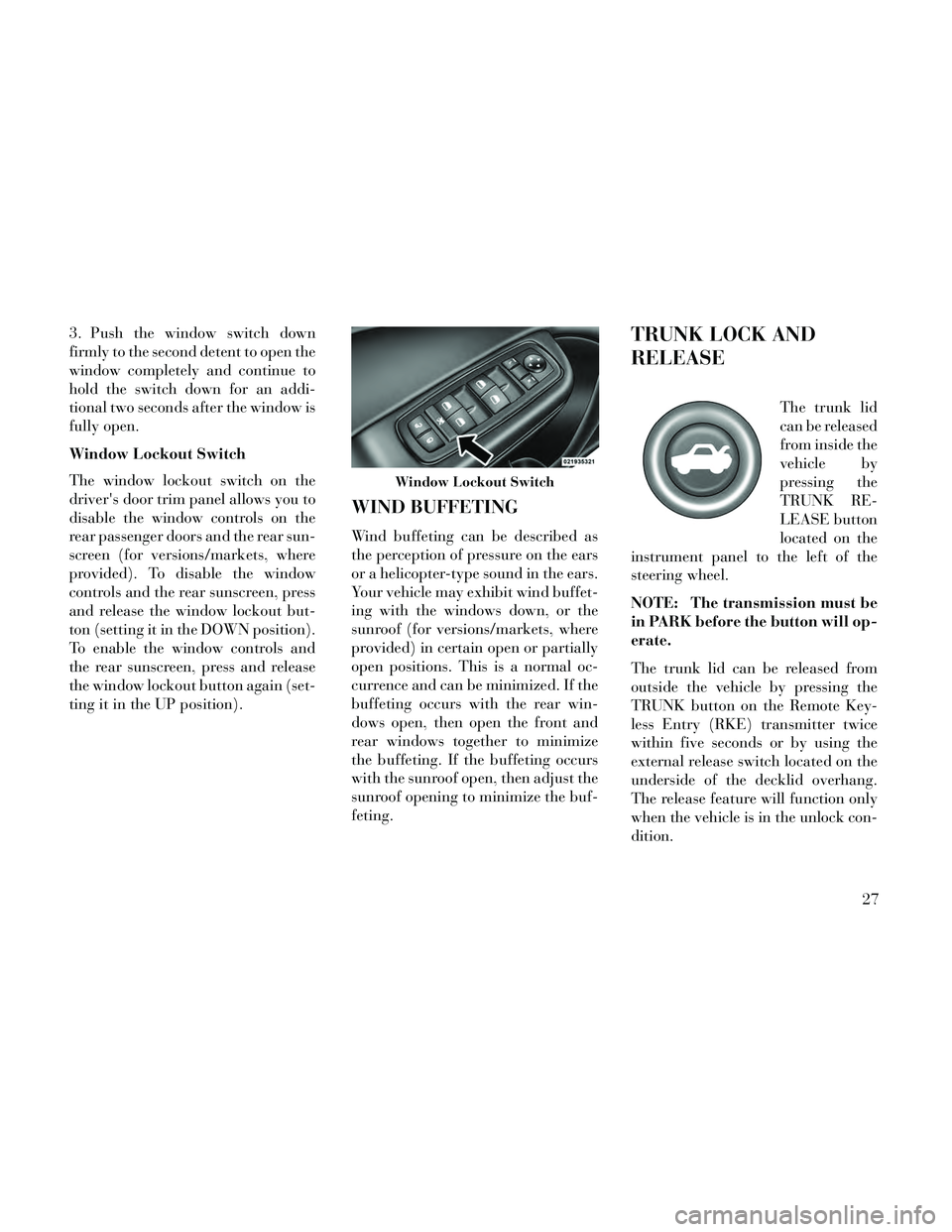
3. Push the window switch down
firmly to the second detent to open the
window completely and continue to
hold the switch down for an addi-
tional two seconds after the window is
fully open.
Window Lockout Switch
The window lockout switch on the
driver's door trim panel allows you to
disable the window controls on the
rear passenger doors and the rear sun-
screen (for versions/markets, where
provided). To disable the window
controls and the rear sunscreen, press
and release the window lockout but-
ton (setting it in the DOWN position).
To enable the window controls and
the rear sunscreen, press and release
the window lockout button again (set-
ting it in the UP position).
WIND BUFFETING
Wind buffeting can be described as
the perception of pressure on the ears
or a helicopter-type sound in the ears.
Your vehicle may exhibit wind buffet-
ing with the windows down, or the
sunroof (for versions/markets, where
provided) in certain open or partially
open positions. This is a normal oc-
currence and can be minimized. If the
buffeting occurs with the rear win-
dows open, then open the front and
rear windows together to minimize
the buffeting. If the buffeting occurs
with the sunroof open, then adjust the
sunroof opening to minimize the buf-
feting.
TRUNK LOCK AND
RELEASE
The trunk lid
can be released
from inside the
vehicle by
pressing the
TRUNK RE-
LEASE button
located on the
instrument panel to the left of the
steering wheel.
NOTE: The transmission must be
in PARK before the button will op-
erate.
The trunk lid can be released from
outside the vehicle by pressing the
TRUNK button on the Remote Key-
less Entry (RKE) transmitter twice
within five seconds or by using the
external release switch located on the
underside of the decklid overhang.
The release feature will function only
when the vehicle is in the unlock con-
dition.
Window Lockout Switch
27
Page 34 of 332
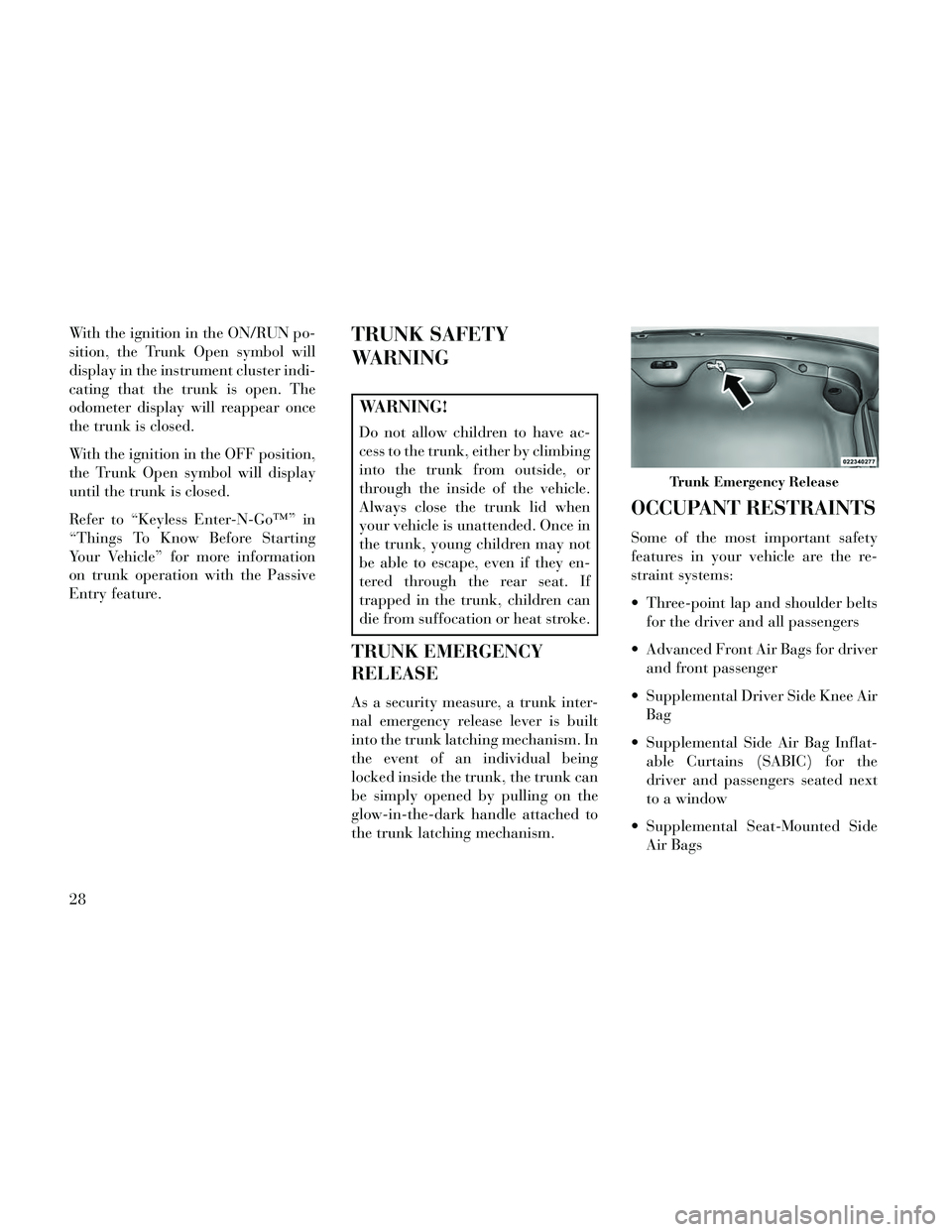
With the ignition in the ON/RUN po-
sition, the Trunk Open symbol will
display in the instrument cluster indi-
cating that the trunk is open. The
odometer display will reappear once
the trunk is closed.
With the ignition in the OFF position,
the Trunk Open symbol will display
until the trunk is closed.
Refer to “Keyless Enter-N-Go™” in
“Things To Know Before Starting
Your Vehicle” for more information
on trunk operation with the Passive
Entry feature.TRUNK SAFETY
WARNING
WARNING!
Do not allow children to have ac-
cess to the trunk, either by climbing
into the trunk from outside, or
through the inside of the vehicle.
Always close the trunk lid when
your vehicle is unattended. Once in
the trunk, young children may not
be able to escape, even if they en-
tered through the rear seat. If
trapped in the trunk, children can
die from suffocation or heat stroke.
TRUNK EMERGENCY
RELEASE
As a security measure, a trunk inter-
nal emergency release lever is built
into the trunk latching mechanism. In
the event of an individual being
locked inside the trunk, the trunk can
be simply opened by pulling on the
glow-in-the-dark handle attached to
the trunk latching mechanism.
OCCUPANT RESTRAINTS
Some of the most important safety
features in your vehicle are the re-
straint systems:
Three-point lap and shoulder beltsfor the driver and all passengers
Advanced Front Air Bags for driver and front passenger
Supplemental Driver Side Knee Air Bag
Supplemental Side Air Bag Inflat- able Curtains (SABIC) for the
driver and passengers seated next
to a window
Supplemental Seat-Mounted Side Air Bags
Trunk Emergency Release
28
Page 35 of 332
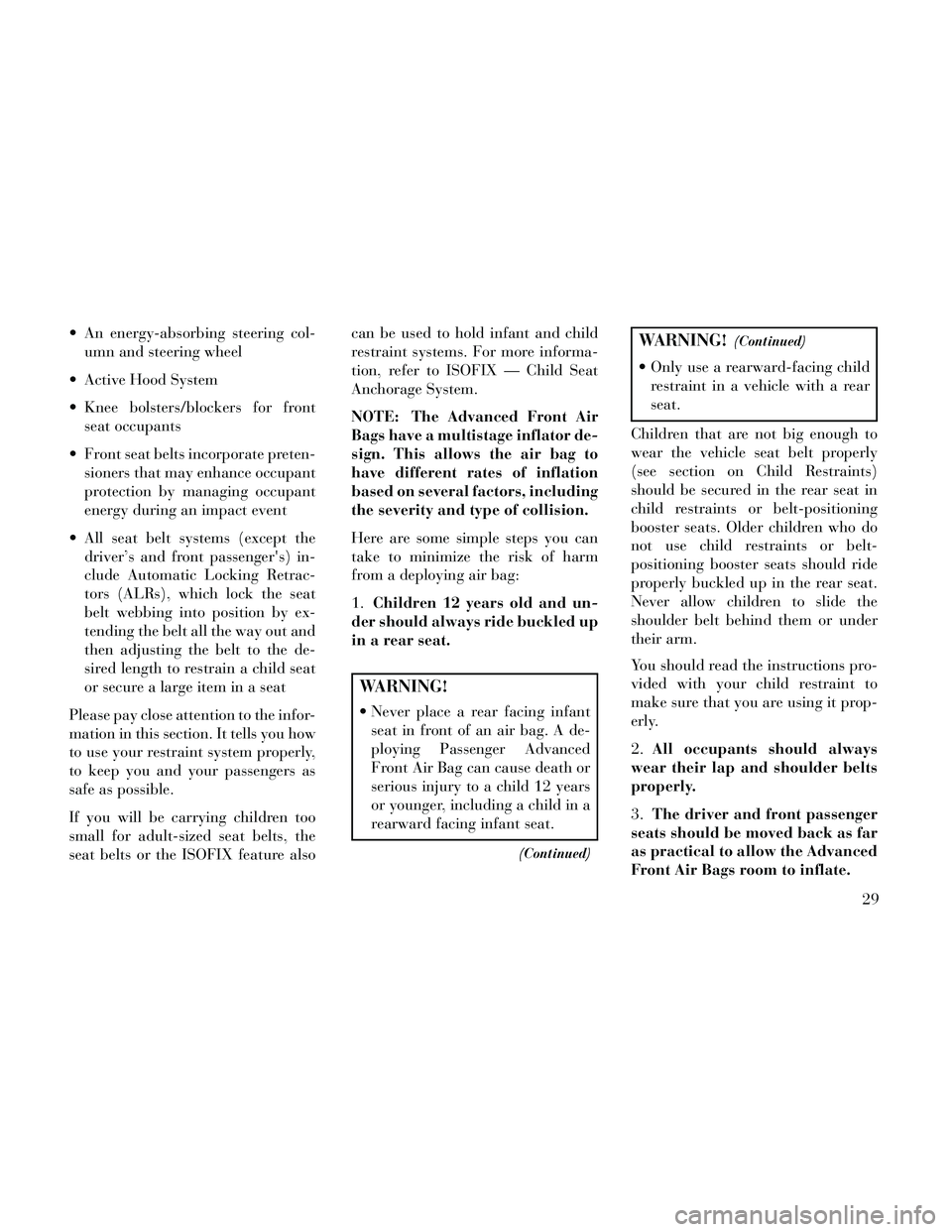
An energy-absorbing steering col-umn and steering wheel
Active Hood System
Knee bolsters/blockers for front seat occupants
Front seat belts incorporate preten- sioners that may enhance occupant
protection by managing occupant
energy during an impact event
All seat belt systems (except the driver’s and front passenger's) in-
clude Automatic Locking Retrac-
tors (ALRs), which lock the seat
belt webbing into position by ex-
tending the belt all the way out and
then adjusting the belt to the de-
sired length to restrain a child seat
or secure a large item in a seat
Please pay close attention to the infor-
mation in this section. It tells you how
to use your restraint system properly,
to keep you and your passengers as
safe as possible.
If you will be carrying children too
small for adult-sized seat belts, the
seat belts or the ISOFIX feature also can be used to hold infant and child
restraint systems. For more informa-
tion, refer to ISOFIX — Child Seat
Anchorage System.
NOTE: The Advanced Front Air
Bags have a multistage inflator de-
sign. This allows the air bag to
have different rates of inflation
based on several factors, including
the severity and type of collision.
Here are some simple steps you can
take to minimize the risk of harm
from a deploying air bag:
1.
Children 12 years old and un-
der should always ride buckled up
in a rear seat.
WARNING!
Never place a rear facing infant seat in front of an air bag. A de-
ploying Passenger Advanced
Front Air Bag can cause death or
serious injury to a child 12 years
or younger, including a child in a
rearward facing infant seat.
(Continued)
WARNING!(Continued)
Only use a rearward-facing childrestraint in a vehicle with a rear
seat.
Children that are not big enough to
wear the vehicle seat belt properly
(see section on Child Restraints)
should be secured in the rear seat in
child restraints or belt-positioning
booster seats. Older children who do
not use child restraints or belt-
positioning booster seats should ride
properly buckled up in the rear seat.
Never allow children to slide the
shoulder belt behind them or under
their arm.
You should read the instructions pro-
vided with your child restraint to
make sure that you are using it prop-
erly.
2. All occupants should always
wear their lap and shoulder belts
properly.
3. The driver and front passenger
seats should be moved back as far
as practical to allow the Advanced
Front Air Bags room to inflate.
29
Page 36 of 332
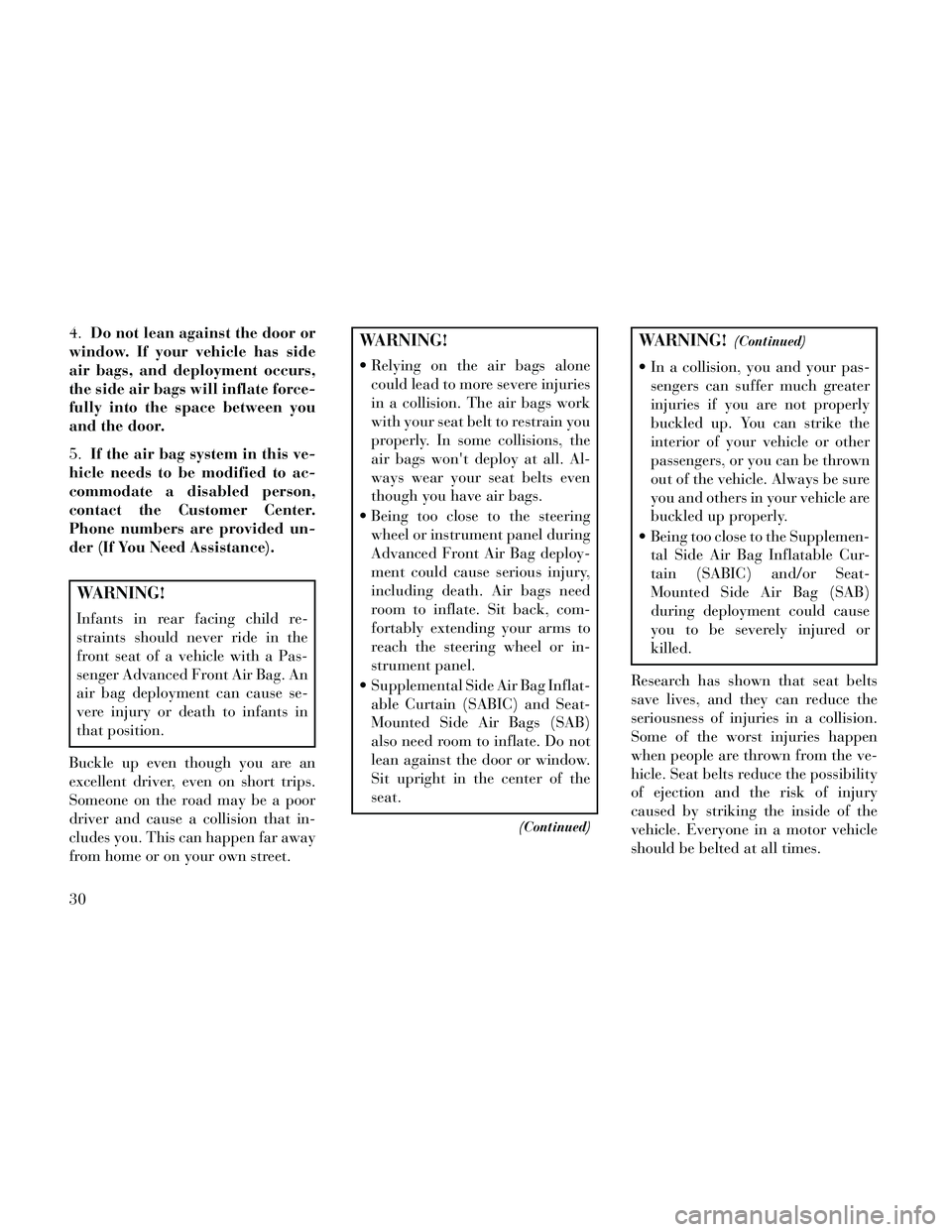
4.Do not lean against the door or
window. If your vehicle has side
air bags, and deployment occurs,
the side air bags will inflate force-
fully into the space between you
and the door.
5. If the air bag system in this ve-
hicle needs to be modified to ac-
commodate a disabled person,
contact the Customer Center.
Phone numbers are provided un-
der (If You Need Assistance).
WARNING!
Infants in rear facing child re-
straints should never ride in the
front seat of a vehicle with a Pas-
senger Advanced Front Air Bag. An
air bag deployment can cause se-
vere injury or death to infants in
that position.
Buckle up even though you are an
excellent driver, even on short trips.
Someone on the road may be a poor
driver and cause a collision that in-
cludes you. This can happen far away
from home or on your own street.
WARNING!
Relying on the air bags alone could lead to more severe injuries
in a collision. The air bags work
with your seat belt to restrain you
properly. In some collisions, the
air bags won't deploy at all. Al-
ways wear your seat belts even
though you have air bags.
Being too close to the steering wheel or instrument panel during
Advanced Front Air Bag deploy-
ment could cause serious injury,
including death. Air bags need
room to inflate. Sit back, com-
fortably extending your arms to
reach the steering wheel or in-
strument panel.
Supplemental Side Air Bag Inflat- able Curtain (SABIC) and Seat-
Mounted Side Air Bags (SAB)
also need room to inflate. Do not
lean against the door or window.
Sit upright in the center of the
seat.
(Continued)
WARNING!(Continued)
In a collision, you and your pas-sengers can suffer much greater
injuries if you are not properly
buckled up. You can strike the
interior of your vehicle or other
passengers, or you can be thrown
out of the vehicle. Always be sure
you and others in your vehicle are
buckled up properly.
Being too close to the Supplemen- tal Side Air Bag Inflatable Cur-
tain (SABIC) and/or Seat-
Mounted Side Air Bag (SAB)
during deployment could cause
you to be severely injured or
killed.
Research has shown that seat belts
save lives, and they can reduce the
seriousness of injuries in a collision.
Some of the worst injuries happen
when people are thrown from the ve-
hicle. Seat belts reduce the possibility
of ejection and the risk of injury
caused by striking the inside of the
vehicle. Everyone in a motor vehicle
should be belted at all times.
30
Page 37 of 332

LAP/SHOULDER BELTS
All seating positions in your vehicle
are equipped with combination lap/
shoulder belts.
The belt webbing retractor is de-
signed to lock during very sudden
stops or impacts. This feature allows
the shoulder part of the belt to move
freely with you under normal condi-
tions. However, in a collision, the belt
will lock and reduce your risk of strik-
ing the inside of the vehicle or being
thrown out.
WARNING!
It is dangerous to ride in a cargoarea, inside or outside of a ve-
hicle. In a collision, people riding
in these areas are more likely to
be seriously injured or killed.
Do not allow people to ride in any area of your vehicle that is not
equipped with seats and seat
belts.
(Continued)
WARNING!(Continued)
Be sure everyone in your vehicle isin a seat and using a seat belt
properly.
Wearing a seat belt incorrectly is dangerous. Seat belts are de-
signed to go around the large
bones of your body. These are the
strongest parts of your body and
can take the forces of a collision
the best.
Wearing your belt in the wrong
place could make your injuries in a
collision much worse. You might
suffer internal injuries, or you
could even slide out of part of the
belt. Follow these instructions to
wear your seat belt safely and to
keep your passengers safe, too.
Two people should never be belted into a single seat belt.
People belted together can crash
into one another in a collision,
hurting one another badly. Never
use a lap/shoulder belt or lap belt
for more than one person, no
matter what their size. LAP/SHOULDER BELT
OPERATING INSTRUCTIONS
1. Enter the vehicle and close the
door. Sit back and adjust the front
seat.
2. The seat belt latch plate is above
the back of your seat. Grasp the latch
plate and pull out the belt. Slide the
latch plate up the webbing as far as
necessary to make the belt go around
your lap.Pulling Out The Lap/Shoulder Belt
Latch Plate
31
Page 38 of 332

3. When the belt is long enough to fit,
insert the latch plate into the buckle
until you hear a “click.”
WARNING!
A belt that is buckled into thewrong buckle will not protect you
properly. The lap portion could
ride too high on your body, possi-
bly causing internal injuries. Al-
ways buckle your belt into the
buckle nearest you.
A belt that is too loose will not protect you properly. In a sudden
stop, you could move too far for-
ward, increasing the possibility of
injury. Wear your seat belt snug.
(Continued)
WARNING!(Continued)
A belt that is worn under yourarm is dangerous. Your body
could strike the inside surfaces of
the vehicle in a collision, increas-
ing head and neck injury. A belt
worn under the arm can cause
internal injuries. Ribs are not as
strong as shoulder bones. Wear
the belt over your shoulder so that
your strongest bones will take the
force in a collision.
A shoulder belt placed behind you will not protect you from in-
jury during a collision. You are
more likely to hit your head in a
collision if you do not wear your
shoulder belt. The lap and shoul-
der belt are meant to be used to-
gether.
4. Position the lap belt across your
thighs, below your abdomen. To re-
move slack in the lap belt portion, pull
up a bit on the shoulder belt. To
loosen the lap belt if it is too tight, tilt
the latch plate and pull on the lap
belt. A snug belt reduces the risk of
sliding under the belt in a collision.
WARNING!
A lap belt worn too high can in- crease the risk of injury in a colli-
sion. The belt forces won't be at
the strong hip and pelvic bones,
but across your abdomen. Always
wear the lap part of your seat belt
as low as possible and keep it
snug.
A twisted belt may not protect you properly. In a collision, it
could even cut into you. Be sure
the belt is straight. If you can't
straighten a belt in your vehicle,
take it to your authorized dealer
immediately and have it fixed.Inserting Latch Plate Into Buckle
Removing Slack From Belt
32
Page 39 of 332
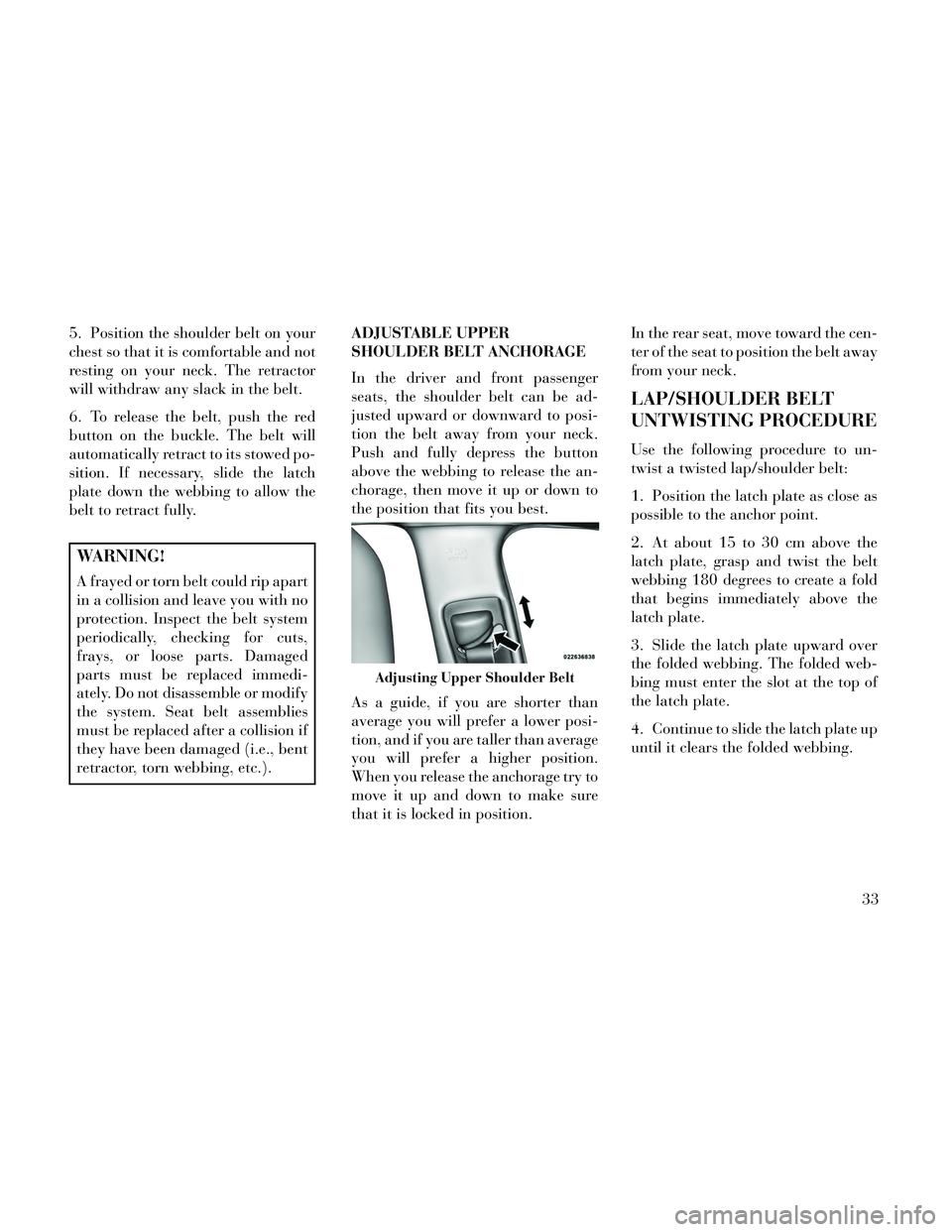
5. Position the shoulder belt on your
chest so that it is comfortable and not
resting on your neck. The retractor
will withdraw any slack in the belt.
6. To release the belt, push the red
button on the buckle. The belt will
automatically retract to its stowed po-
sition. If necessary, slide the latch
plate down the webbing to allow the
belt to retract fully.
WARNING!
A frayed or torn belt could rip apart
in a collision and leave you with no
protection. Inspect the belt system
periodically, checking for cuts,
frays, or loose parts. Damaged
parts must be replaced immedi-
ately. Do not disassemble or modify
the system. Seat belt assemblies
must be replaced after a collision if
they have been damaged (i.e., bent
retractor, torn webbing, etc.).ADJUSTABLE UPPER
SHOULDER BELT ANCHORAGE
In the driver and front passenger
seats, the shoulder belt can be ad-
justed upward or downward to posi-
tion the belt away from your neck.
Push and fully depress the button
above the webbing to release the an-
chorage, then move it up or down to
the position that fits you best.
As a guide, if you are shorter than
average you will prefer a lower posi-
tion, and if you are taller than average
you will prefer a higher position.
When you release the anchorage try to
move it up and down to make sure
that it is locked in position. In the rear seat, move toward the cen-
ter of the seat to position the belt away
from your neck.
LAP/SHOULDER BELT
UNTWISTING PROCEDURE
Use the following procedure to un-
twist a twisted lap/shoulder belt:
1. Position the latch plate as close as
possible to the anchor point.
2. At about 15 to 30 cm above the
latch plate, grasp and twist the belt
webbing 180 degrees to create a fold
that begins immediately above the
latch plate.
3. Slide the latch plate upward over
the folded webbing. The folded web-
bing must enter the slot at the top of
the latch plate.
4. Continue to slide the latch plate up
until it clears the folded webbing.
Adjusting Upper Shoulder Belt
33
Page 40 of 332

SEAT BELTS IN
PASSENGER SEATING
POSITIONS
The seat belts in the rear passenger
seating positions are equipped with
Automatic Locking Retractors (ALR)
which are used to secure a child re-
straint system. For additional infor-
mation, refer to “Installing Child Re-
straints Using The Vehicle Seat Belt”
under the “Child Restraints” section.
The chart below defines the type of
feature for each seating position.
Driver Cen-terPas-
senger
First Row N/A N/A ALR
Second Row ALR ALR ALR
N/A — Not Applicable
ALR — Automatic Locking Retrac- tor If the passenger seating position is
equipped with an ALR and is being
used for normal usage:
Only pull the belt webbing out far
enough to comfortably wrap around
the occupant's mid-section so as to
not activate the ALR. If the ALR is
activated, you will hear a ratcheting
sound as the belt retracts. Allow the
webbing to retract completely in this
case and then carefully pull out only
the amount of webbing necessary to
comfortably wrap around the occu-
pant's mid-section. Slide the latch
plate into the buckle until you hear a
"click."
AUTOMATIC LOCKING
RETRACTOR MODE (ALR)
In this mode, the shoulder belt is au-
tomatically pre-locked. The belt will
still retract to remove any slack in the
shoulder belt. The Automatic Locking
Mode is available on all passenger-
seating positions with a combination
lap/shoulder belt. Use the Automatic
Locking Mode anytime a child safety
seat is installed in a seating position that has a belt with this feature. Chil-
dren 12 years old and under should
always be properly restrained in the
rear seat.
How To Engage The Automatic
Locking Mode
1. Buckle the combination lap and
shoulder belt.
2. Grasp the shoulder portion and
pull downward until the entire belt is
extracted.
3. Allow the belt to retract. As the
belt retracts, you will hear a clicking
sound. This indicates the safety belt is
now in the Automatic Locking Mode.
How To Disengage The Automatic
Locking Mode
Unbuckle the combination lap/
shoulder belt and allow it to retract
completely to disengage the Auto-
matic Locking Mode and activate the
vehicle sensitive (emergency) locking
mode.
34